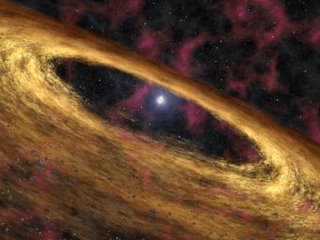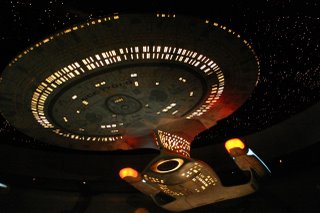Monday, November 13, 2006
Star Treks 40th Year : Timetrek Video.
Celebrate captured moments in time with Star Trek's heros and villians. This nostalgic video illustrates over 40 years of Star Trek's hopeful, deepspace exploration adventures with five generations of crew.... Our Federation heroes overwhelm the firey flames of passion within all yearning hearts as they warp towards vast reservoirs of wisdom hidden beyond the Final Frontier.... Enjoy.
Live Long and Prosper. Trekkies and Trekkers!
Sunday, November 12, 2006
Pulsar Star Movie
Following up on my last Pulsar post I felt compelled to share this discovery. Here is an image of an artists creation which shows the interstellar remains of space debris, orbiting around the pulsar called 4u 0142+61. Over 100,000 years ago a massive star blew up giving birth to a baby pulsar. The explosion spewed forth a fallback disk of rocks and space dust captured in the orbit of the reborn pulsar. NASA's Spitzer Space Telescope discovered this space marvel 13,000 light years away in the Northern Constellation Cassiopeia.

Image Credit: NASA/JPL-CALTECH.
In Pulsar Rubble you will find fascinating details about the physics of this enticing space phenomenon, star composition, death and re-birth of planets plus a thrilling little space movie! Why didn't the supernova blast disperse all the planets debris and space dust? find out.
Its an awesome inspirational short movie giving an uptake on the unfolding of a giant star in our universe, beyond imagination. It can take 5 minutes to download in Quicktime player, but it is well worth the wait believe me.
How it works. You can see the short movie animation by clicking on the four thumbprint images within the above link, marked the birth of the "Phoenix Planets." Watch for yourself an electrifying rotating radiant super giant star..... well you didn't expect me to tell you the rest of it, did you?
Enjoy the movie, Live Long and Prosper!

Image Credit: NASA/JPL-CALTECH.
In Pulsar Rubble you will find fascinating details about the physics of this enticing space phenomenon, star composition, death and re-birth of planets plus a thrilling little space movie! Why didn't the supernova blast disperse all the planets debris and space dust? find out.
Its an awesome inspirational short movie giving an uptake on the unfolding of a giant star in our universe, beyond imagination. It can take 5 minutes to download in Quicktime player, but it is well worth the wait believe me.
How it works. You can see the short movie animation by clicking on the four thumbprint images within the above link, marked the birth of the "Phoenix Planets." Watch for yourself an electrifying rotating radiant super giant star..... well you didn't expect me to tell you the rest of it, did you?
Enjoy the movie, Live Long and Prosper!
Saturday, November 11, 2006
Pulsar Star System

Shining brightly, this pulsar PSR B1257+12 greets its neighbouring three planets every day. Alexksander Wolszczan discovered this extreme planetary system and pulsar in 1992 using a Arecibo Radio Telescope. The pulsar, once an impressive massive star is now a collapsed core of a rapidly rotating neutron star. This shadow of its former self is constantly rotating and pulsing radiation.
Pulsar Solar System
Image Credit: NASA/JPL-Caltech
Supergiants have a mass 10 - 100 times that of our own sun. The larger the star the faster the fuel burns. The nuclear fusion of hydrogen into helium makes a star shine. When the fuel runs out and the star expands into a red supergiant, it has reached the latter stage of stellar evolution. The core cools and contracts suddenly causing an explosion, called a supernova which blasts away the star's outer layers.
This is one place you don't wan't to be when that happens.
"Mr Crusher, Warp 9 , Engage, Engage! Make it so! Comon Wesley, get us out of here!" Panics Picard.
"I Know, I know, captain, don't pressure me. It's that button is'nt it? " cries Wesley horrified.

If the core survives , which it did here just after the Enterprise made her lucky escape, the explosion cools and contracts further into a small, dense neutron star or pulsar. The pulsars three planets are most likely hatchling planets.
Pulsars
Its logical to assume the shockwave from the once mighty star, blew everything to smithereens in its path, leaving behind planet debris and space dust to form new worlds.
Live long and Prosper Trekkers! Star Trekking is fun.
Subscribe to:
Posts (Atom)
Featured Post
CAPTAIN PICARD TV SERIES
So analysis has begun with Star Trek Picard's trailer... after a 17 year TNG hiatus some of trek's icons have returned. Here we ca...

